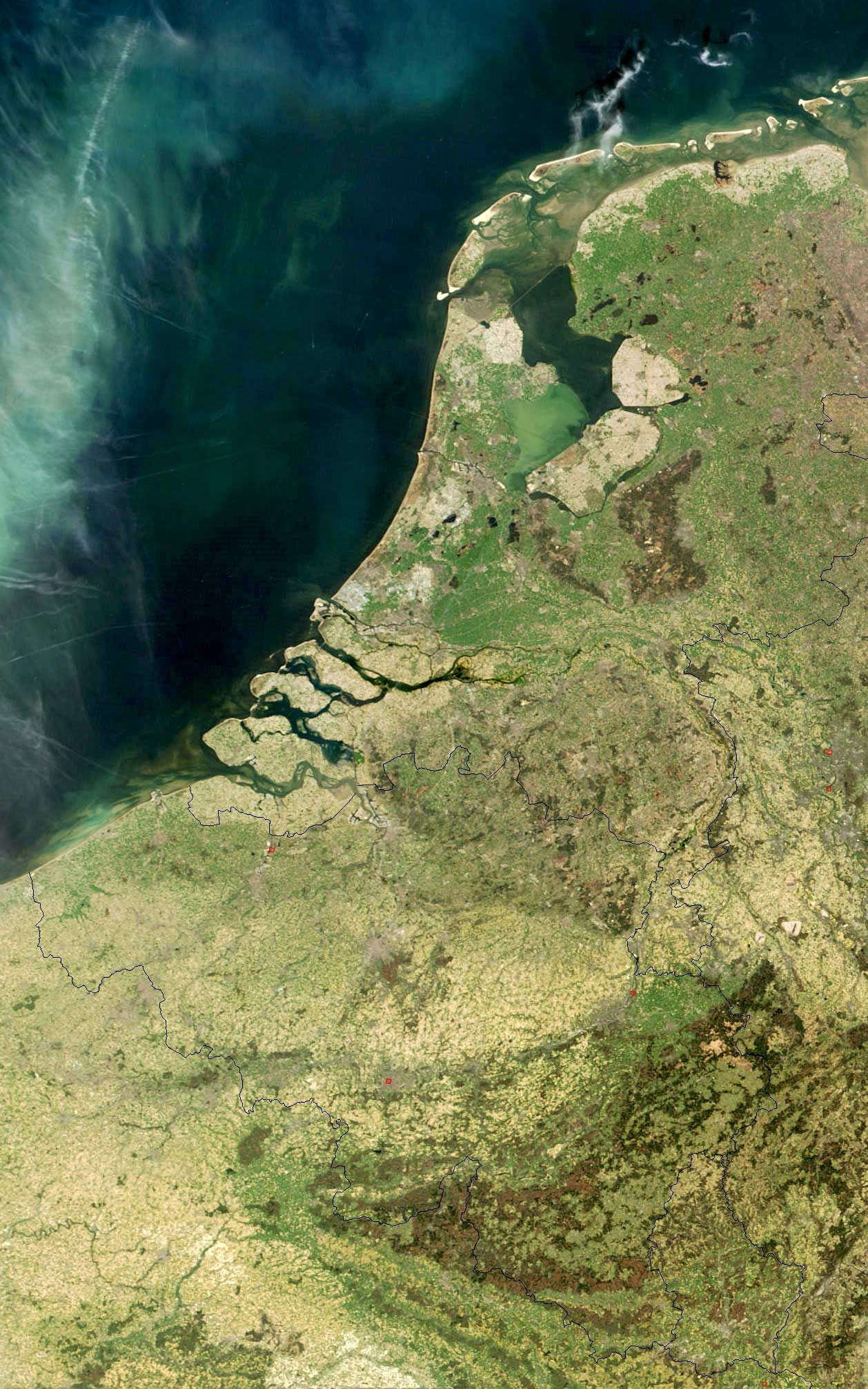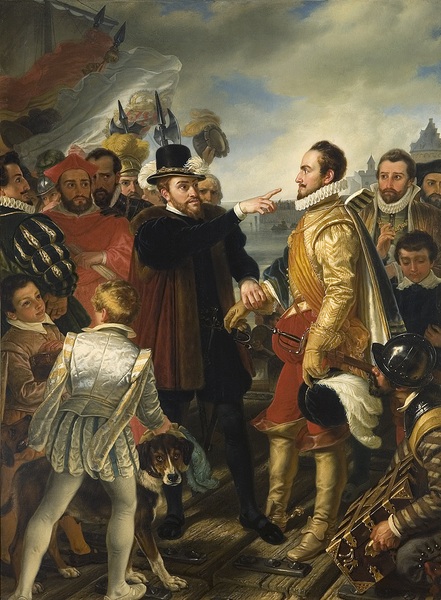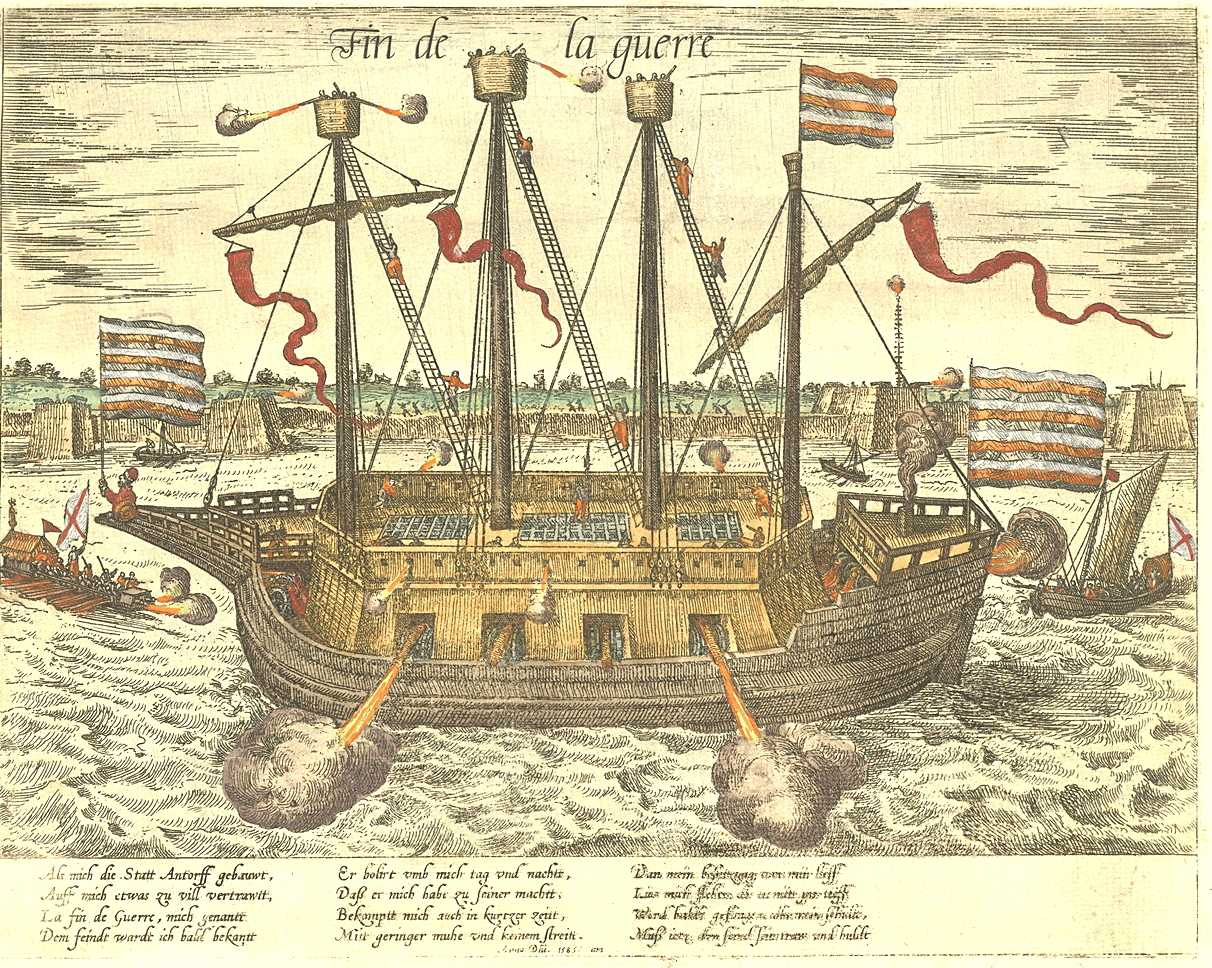|
Dutch Republic Lion
The Dutch Republic Lion (also known as States Lion) was the badge of the Union of Utrecht, the Republic of the Seven United Netherlands, and a precursor of the current coat of arms of the Kingdom the Netherlands. Background When the county of Flanders was inherited by the Dukes of Burgundy in 1405, the Flemish lion (black on gold) was placed on an escutcheon in their dynastic arms (see Armorial of the French Royal House or Armorial of Dukes of Burgundy). The same happened with the duchy of Brabant (and its dependent duchy of Limburg) in 1430 (gold lion on black for Brabant, red lion on white for Limburg), but oddly not the county of Holland (red lion on gold shield) in 1432 or the duchy of Luxembourg (red lion on blue and white bars). These passed with the rest of the Burgundian inheritance to the House of Habsburg in 1482. Their descendants, the Kings of Spain bear the title of the county of Flanders (Holland was renounced in 1648 with the Treaty of Westphalia) and the du ... [...More Info...] [...Related Items...] OR: [Wikipedia] [Google] [Baidu] [Amazon] |
Dutch Republic
The United Provinces of the Netherlands, commonly referred to in historiography as the Dutch Republic, was a confederation that existed from 1579 until the Batavian Revolution in 1795. It was a predecessor state of the present-day Netherlands and the first independent Dutch people, Dutch nation state. The republic was established after seven Dutch provinces in the Spanish Netherlands Dutch Revolt, revolted against Spanish Empire, Spanish rule, forming a mutual alliance against Spain in 1579 (the Union of Utrecht) and declaring their independence in 1581 (the Act of Abjuration). The seven provinces it comprised were Lordship of Groningen, Groningen (present-day Groningen (province), Groningen), Lordship of Frisia, Frisia (present-day Friesland), Lordship of Overijssel, Overijssel (present-day Overijssel), Duchy of Guelders, Guelders (present-day Gelderland), lordship of Utrecht, Utrecht (present-day Utrecht (province), Utrecht), county of Holland, Holland (present-day North Holla ... [...More Info...] [...Related Items...] OR: [Wikipedia] [Google] [Baidu] [Amazon] |
Low Countries
The Low Countries (; ), historically also known as the Netherlands (), is a coastal lowland region in Northwestern Europe forming the lower Drainage basin, basin of the Rhine–Meuse–Scheldt delta and consisting today of the three modern "Benelux" countries: Belgium, Luxembourg, and the Netherlands (, which is singular). Geographically and historically, the area can also include parts of France (such as Nord (French department), Nord and Pas-de-Calais) and the Germany, German regions of East Frisia, Geldern, Guelders and Cleves. During the Middle Ages, the Low Countries were divided into numerous semi-independent principalities. Historically, the regions without access to the sea linked themselves politically and economically to those with access to form various unions of ports and hinterland, stretching inland as far as parts of the German Rhineland. Because of this, nowadays not only physically low-altitude areas, but also some hilly or elevated regions are considered part of ... [...More Info...] [...Related Items...] OR: [Wikipedia] [Google] [Baidu] [Amazon] |
Act Of Abjuration
The Act of Abjuration (; ) is the declaration of independence by many of the provinces of the Netherlands from their allegiance to Philip II of Spain, during the Dutch Revolt. Signed on 26 July 1581, in The Hague, the Act formally confirmed a decision made by the States General of the Netherlands in Antwerp four days earlier. It declared that all magistrates in the provinces making up the Union of Utrecht were freed from their oaths of allegiance to their lord, Philip, who was also King of Spain. The grounds given were that Philip had failed in his obligations to his subjects, by oppressing them and violating their ancient rights. Philip was therefore considered to have forfeited his thrones as ruler of each of the provinces which signed the Act. The Act of Abjuration allowed the newly independent territories to govern themselves, although they first offered their thrones to alternative candidates. When this failed in 1587 by, among other things, the deduction of François Vr ... [...More Info...] [...Related Items...] OR: [Wikipedia] [Google] [Baidu] [Amazon] |
Arms Of François, Duke Of Anjou And Alençon (as Sovereign Of The Netherlands)
Arms or ARMS may refer to: *Arm or arms, the upper limbs of the body Arm, Arms, or ARMS may also refer to: People * Ida A. T. Arms (1856–1931), American missionary-educator, temperance leader Coat of arms or weapons *Armaments or weapons **Firearm *Coat of arms **In this sense, "arms" is a common element in pub names Enterprises *Amherst Regional Middle School *Arms Corporation, originally named Dandelion, a defunct Japanese animation studio who operated from 1996 to 2020 *TRIN (finance) or Arms Index, a short-term stock trading index *Australian Relief & Mercy Services, a part of Youth With A Mission Arts and entertainment *ARMS (band), an American indie rock band formed in 2004 *Arms (album), ''Arms'' (album), a 2016 album by Bell X1 *Arms (song), "Arms" (song), a 2011 song by Christina Perri from the album ''lovestrong'' *Arms (video game), ''Arms'' (video game), a 2017 fighting video game for the Nintendo Switch *ARMS Charity Concerts, a series of charitable rock concerts ... [...More Info...] [...Related Items...] OR: [Wikipedia] [Google] [Baidu] [Amazon] |
Reduction Of Groningen
Reduction, reduced, or reduce may refer to: Science and technology Chemistry * Reduction (chemistry), part of a reduction-oxidation (redox) reaction in which atoms have their oxidation state changed. ** Organic redox reaction, a redox reaction that takes place with organic compounds ** Ore reduction: see smelting Computing and algorithms * Reduction (complexity), a transformation of one problem into another problem * Reduction (recursion theory), given sets A and B of natural numbers, is it possible to effectively convert a method for deciding membership in B into a method for deciding membership in A? * Bit Rate Reduction, an audio compression method * Data reduction, simplifying data in order to facilitate analysis * Graph reduction, an efficient version of non-strict evaluation * L-reduction, a transformation of optimization problems which keeps the approximability features * Partial order reduction, a technique for reducing the size of the state-space to be se ... [...More Info...] [...Related Items...] OR: [Wikipedia] [Google] [Baidu] [Amazon] |
William The Silent
William the Silent or William the Taciturn (; 24 April 153310 July 1584), more commonly known in the Netherlands as William of Orange (), was the leader of the Dutch revolt against the Spanish Habsburg Netherlands, Habsburgs that set off the Eighty Years' War (1568–1648) and resulted in the formal independence of the Dutch Republic, United Provinces in 1648. Born into the House of Nassau, he became Prince of Orange in 1544 and is thereby the founder of the House of Orange-Nassau, Orange-Nassau branch and the ancestor of the monarchy of the Netherlands. In the Netherlands, he is also known as Father of the Nation, Father of the Fatherland (; ). A wealthy nobleman, William originally served the Habsburgs as a member of the court of Margaret of Parma, governor of the Spanish Netherlands. Unhappy with the centralisation of political power away from the local estates and with the Spanish persecution of Dutch Protestants, William joined the Dutch uprising and turned against his fo ... [...More Info...] [...Related Items...] OR: [Wikipedia] [Google] [Baidu] [Amazon] |
Fall Of Antwerp
The fall of Antwerp ( ) on 17 August 1585 took place during the Eighty Years' War, after a siege lasting over a year from July 1584 until August 1585. The city of Antwerp was the focal point of the Protestant-dominated Dutch Revolt, but was forced to surrender to the Spanish forces under the command of Alessandro Farnese. Under the terms agreed, all the Protestants of Antwerp were given four years to settle their affairs and leave the city. Many migrated north, especially to Amsterdam. Apart from losing a high proportion of its middle class and mercantile population, Antwerp's trade suffered for two centuries afterwards as Dutch forts blockaded the River Scheldt until 1795. Background At the time Antwerp, in modern Belgium, was not only the largest Dutch city, but was also the cultural, economic, and financial centre of the Seventeen Provinces and of Northwestern Europe. On 4 November 1576, unpaid Spanish soldiery mutinied: they plundered and burnt the city during what was ca ... [...More Info...] [...Related Items...] OR: [Wikipedia] [Google] [Baidu] [Amazon] |
Dutch Ship De Zeven Provinciën (1665)
(Dutch language, Dutch: "the seven provinces") was a Dutch ship of the line, originally armed with 80 guns. The name of the ship refers to the seven autonomous provinces that made up the Dutch Republic in the 17th century. The vessel was built in 1664-65 for the Admiralty of Rotterdam, Admiralty of de Maze in Rotterdam by the master shipbuilder Salomon Jansz van den Tempel. History The ship served as Admiral Michiel de Ruyter's flagship during the Second Anglo-Dutch War, taking part in the Dutch victory at the Four Days Fight and the defeat at the St. James's Day Battle, and acting as a command post as well as blockading the River Thames during the Raid on the Medway. The vessel performed well throughout the war, though it was partially dismasted during the Four Days Fight. De Ruyter used as his flagship during the Third Anglo-Dutch War of 1672-1673. The ship served in all four major battles against the combined English and French fleet, fighting in the Battle of Solebay ... [...More Info...] [...Related Items...] OR: [Wikipedia] [Google] [Baidu] [Amazon] |
Crown (heraldry)
A crown is often an emblem of a sovereign state, usually a monarchy (see The Crown), but also used by some republics. A specific type of crown is employed in heraldry under strict rules. Indeed, some monarchies never had a physical Crown (headgear), crown, just a heraldic representation, as in the constitutional kingdom of Belgium. Crowns are also often used as symbols of religious status or veneration, by divinities (or their representation such as a statue) or by their representatives, e.g. the Black Crown of the Karmapa, Karmapa Lama, sometimes used a model for wider use by devotees. A crown can be a charge (heraldry), charge ''in'' a coat of arms, or set ''atop'' the shield to signify the status of its owner, as with the coat of arms of Norway. Physical and heraldic crowns Sometimes, the crown commonly depicted and used in heraldry differs significantly from any specific physical crown that may be used by a monarchy. As a display of rank If the bearer of a coat of arms ... [...More Info...] [...Related Items...] OR: [Wikipedia] [Google] [Baidu] [Amazon] |
States-General Of The Netherlands
The States General of the Netherlands ( ) is the supreme bicameral legislature of the Netherlands consisting of the Senate () and the House of Representatives (). Both chambers meet at the Binnenhof in The Hague. The States General originated in the 15th century as an assembly of all the provincial states of the Burgundian Netherlands. In 1579, during the Dutch Revolt, the States General split as the northern provinces openly rebelled against Philip II, and the northern States General replaced Philip II as the supreme authority of the Dutch Republic in 1581. The States General were replaced by the National Assembly after the Batavian Revolution of 1795, only to be restored in 1814, when the country had regained its sovereignty. The States General was divided into a Senate and a House of Representatives in 1815, with the establishment of the United Kingdom of the Netherlands. After the constitutional amendment of 1848, members of the House of Representatives were directly elect ... [...More Info...] [...Related Items...] OR: [Wikipedia] [Google] [Baidu] [Amazon] |
Sovereignty
Sovereignty can generally be defined as supreme authority. Sovereignty entails hierarchy within a state as well as external autonomy for states. In any state, sovereignty is assigned to the person, body or institution that has the ultimate authority over other people and to change existing laws. In political theory, sovereignty is a substantive term designating supreme legitimate authority over some polity. In international law, sovereignty is the exercise of power by a state. ''De jure'' sovereignty refers to the legal right to do so; '' de facto'' sovereignty refers to the factual ability to do so. This can become an issue of special concern upon the failure of the usual expectation that ''de jure'' and ''de facto'' sovereignty exist at the place and time of concern, and reside within the same organization. Etymology The term arises from the unattested Vulgar Latin *''superanus'' (itself a derived form of Latin ''super'' – "over") meaning "chief", "ruler". Its spellin ... [...More Info...] [...Related Items...] OR: [Wikipedia] [Google] [Baidu] [Amazon] |
Count Of Holland
The counts of Holland ruled over the County of Holland in the Low Countries between the 10th and the 16th century. The Frisian origins While the Frisian kingdom had comprised most of the present day Netherlands, the later province of Friesland in the Netherlands was much reduced. Already in the early Middle Ages West-Frisia (Frisia west of the Vlie) was not considered to be a part of Frisia anymore, and came to be known as Holland (present day provinces North and South Holland and Zeeland). Floris II was the first count who restyled his name from count of "West-Frisia", in count of "Holland". Frisia Proper in medieval time therefore only included the middle and eastern part. The middle part (corresponding to the present day Dutch province of Friesland) was populated by free peasants who successfully resisted all attempts by feudal lords to subdue them, mainly the counts of Holland and the bishops of Utrecht. In the eastern part, local chieftains created their own states (withi ... [...More Info...] [...Related Items...] OR: [Wikipedia] [Google] [Baidu] [Amazon] |






